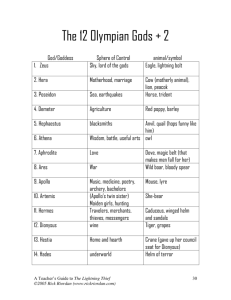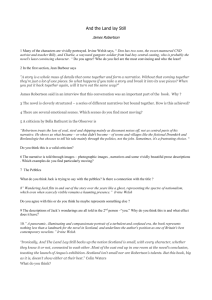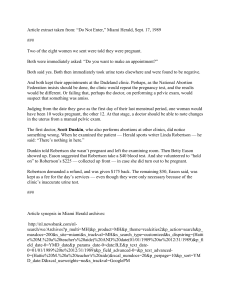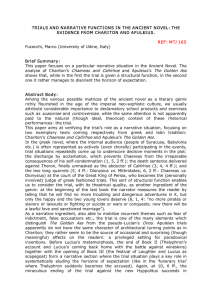HERE
advertisement
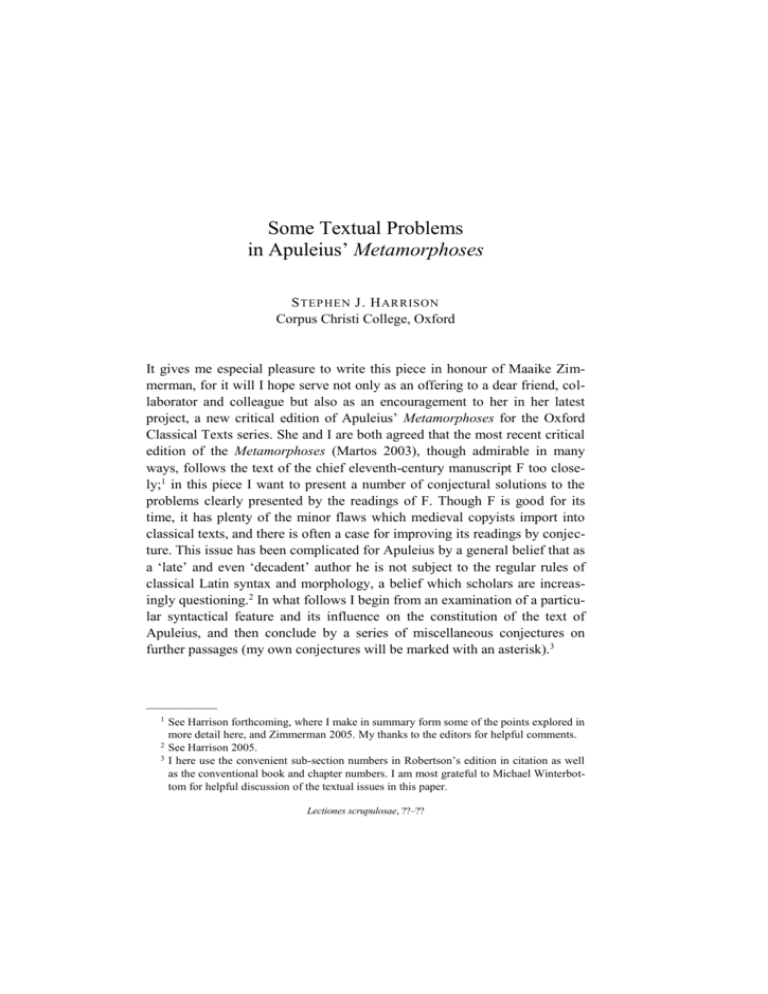
Some Textual Problems in Apuleius’ Metamorphoses S TEP HEN J. H ARRISON Corpus Christi College, Oxford It gives me especial pleasure to write this piece in honour of Maaike Zimmerman, for it will I hope serve not only as an offering to a dear friend, collaborator and colleague but also as an encouragement to her in her latest project, a new critical edition of Apuleius’ Metamorphoses for the Oxford Classical Texts series. She and I are both agreed that the most recent critical edition of the Metamorphoses (Martos 2003), though admirable in many ways, follows the text of the chief eleventh-century manuscript F too closely;1 in this piece I want to present a number of conjectural solutions to the problems clearly presented by the readings of F. Though F is good for its time, it has plenty of the minor flaws which medieval copyists import into classical texts, and there is often a case for improving its readings by conjecture. This issue has been complicated for Apuleius by a general belief that as a ‘late’ and even ‘decadent’ author he is not subject to the regular rules of classical Latin syntax and morphology, a belief which scholars are increasingly questioning.2 In what follows I begin from an examination of a particular syntactical feature and its influence on the constitution of the text of Apuleius, and then conclude by a series of miscellaneous conjectures on further passages (my own conjectures will be marked with an asterisk).3 ————— 1 2 3 See Harrison forthcoming, where I make in summary form some of the points explored in more detail here, and Zimmerman 2005. My thanks to the editors for helpful comments. See Harrison 2005. I here use the convenient sub-section numbers in Robertson’s edition in citation as well as the conventional book and chapter numbers. I am most grateful to Michael Winterbottom for helpful discussion of the textual issues in this paper. Lectiones scrupulosae, ??–?? 2 S TE PHE N HAR R IS ON 1 Asyndeton bimembre The text of F presents a number of examples of this phenomenon, in which two syntactically equivalent words, usually closely related or opposite in sense, are juxtaposed without the intervening connective word normally expected in classical Latin.4 This type of expression is well documented in archaic Latin, especially in certain kinds of formulaic expressions, but the assumption that it is therefore usually satisfactory in non-formulaic expressions in Apuleius could be argued to be based on a misunderstanding of how Apuleius’ Kunstprosa is generated. Though Apuleius’ debt to archaic Latin in terms of his lexicon has been extensively demonstrated by Callebat and others,5 there is little evidence that Apuleius’ complex and elaborate syntax owes much to archaic Latin models.6 It is true that asyndeton bimembre is found in a range of Latin prose texts of the classical and post-classical periods, especially for example in the Minor Declamations attributed to Quintilian;7 but normally this mode of expression occurs in established archaising formulas or emotionally intense locutions, and/or is placed in an emphatic location at the beginning or end of a sentence.8 In Apuleius, by contrast, almost all the transmitted examples of asyndeton bimembre seem to be unformulaic, relatively unemphatic and in mid-sentence. In a number of places a transmitted mid-sentence asyndeton bimembre has been supplemented by an easily-generated connective in at least one of the major modern editions9 (in what follows ς indicates a humanistic conjecture): 1,18,1 et ego curiose sedulo arbitrabar iugulum comitis F, Robertson; curiose et sedulo Helm. 4,8,2 nam et ipsi praedas aureorum argentiariorum nummorum ac uasculorum uestisque sericae et intextae filis aureis inuehebant F, argentiariorumque ς, Helm, Robertson. ————— 4 5 6 7 8 9 For further literature see Hofmann/Szantyr/Traina 2002, 241–243. Callebat 1968. Bernhard 1927 remains the best account of the complexities of Apuleian syntax. See Winterbottom 1984, 322–323. So Winterbottom 1984, 322. This means Helm 1931 and Robertson 1940–1945. S OME TE XTUAL P R OB LE M S IN APU LE IUS ’ M E TAM OR PHOSE S 3 6,1,5 rata scilicet nullius dei fana caerimonias neglegere se debere F,10 fana <et> caerimonias ς, Helm, fana caeremoniasue coni. Robertson. 6,28,6 sinu serico progestans nucleos edulia mitiora F; nucleos <et> edulia Salmasius, Helm, Robertson. 9,41,4 tunc magistratus et damno praesidis nomine cognito F, <et> praesidis Pricaeus, Helm, Robertson: et is clearly needed for co-ordination here. 10,2,1 iuuenem filium probe litteratum et ob id consequenter pietate modestia praecipuum F, Helm, Robertson; pietate et modestia Scriverius, ‘fort.recte’ Robertson in app.crit. In all these cases I would agree with the supplement. In the remaining places where this construction is apparently found in the Metamorphoses equally simple corrections or re-interpretations can be supplied:11 4,2,5 iam enim loco proximus non illas rosas teneras et amoenas, madidas diuini roris et nectaris, quas rubi felices beatae spinae generant F; rubi felices <et> beatae spinae ς. The humanistic conjecture here duly puts in the connective, but interpreting the phrase as asyndeton bimembre can be avoided without change, by considering beatae spinae as in apposition with rubi felices – ‘fortunate brambles, blessed thorns’. 5,31,2 Psychen illam fugitiuam uolaticam mihi requirite F, Helm, Robertson. This is one of the few passages where emotional intensity might justify the asyndeton bimembre (Venus is clearly passionate here), but it is worth thinking about fugitiuam <*ac> uolaticam, or viewing fugitiuam as nominalised here (for this substantive use of fugitiua see TLL 6,1,1496,71–73). 9,17,4 mortem denique uiolentam defamem comminatus F, Helm. GCA 1995 ad loc. defend the transmitted asyndeton, but it has often been questioned. Robertson conjectured mortem denique illam lentam de fame, but violence seems appropriate here; Hildebrand read mortem uiolentam ac nefantem; ————— 10 11 F in fact has neclegese, rightly corrected by most later MSS and all editors. These are the remaining passages noted by Bernhard 1927, 55–56. 4 S TE PHE N HAR R IS ON nefantem is questionable morphology, defamem is fine (see GCA ad loc.) and denique is appropriate at the end of this list of threats and should stay, but a simple connective could be supplied here – mortem denique uiolentam <*ac> defamem. 9,36,4 canes pastoricios uillaticos feros atque immanes F, Helm, Robertson. The first pair of adjectives surely needs a connection like that in the second: read pastoricios <*ac> villaticos. GCA 1995 ad loc. compares 8,15,6 lupos enim numerosos grandes et uastis corporibus sarcinosos ac nimia ferocitate saeuientes, but in that passage there is clearly a syntactical pause after numerosos, with grandes then forming the first element of a tricolon. Finally, for an element of control we may compare the large number of similar phrases where the connective in such pairings is indubitably transmitted, which show that such syndetic pairs (especially alliterative or assonant ones) are a frequent feature of Apuleian style in the Metamorphoses: cf. e.g. 1,1,5 exotici ac forensis, 1,4,4 eneruam et exossam, 1,6,2 defletus et conclamatus, 1,15,4 marcidus et semisopitus, 2,8,5 eximiae pulcherrimaeque, 2,22,6 decerptum deminutumque, 2,26,3 multumque ac diu, 3,24,2 amplexus ac deosculatus, 3,26,2 nequissimam facinerosissimamque, 3,28,3 obsaeptum obseratumque, 4,4,5 exanimatum ac debilem, 4,7,4 fortissimi fidelissimique, 4,9,6 solus ac solitarius, 4,12,8 perfracta diffissaque, 4,20,5 miserum funestumque, 4,21,1 procerus et ualidus [again 9,37,7], 4,24,5 innata atque innutrita, 4,26,4 nutritus et adultus, 4,26,4 cubiculi torique, 4,27,6 lucrosum prosperumque, 4,31,4 diu ac pressule, 5,1,2 proceris et uastis, 5,1,3 luculentum et amoenum, 5,1,6 longe lateque [again 10,27,3], 5,8,3 scrupulose curioseque, 5,10,1 complicatum curuatumque, 5,22,2 mitissimam dulcissimamque, 6,2,1 sollicite seduloque, 6,3,2 retenta custoditaque, 6,9,1 inductam oblatamque, 6,10,3 dispositis atque seiugatis, 6,10,7 distributis dissitisque, 7,10,3 spurci sordidique, 7,13,6 prolatis erutisque, 7,20,3 deterrimus ac temerarius, 7,21,1 pigrum tardissimumque, 7,21,2 illicitas atque incognitas, 7,21,4 abiecto dispersoque, 7,21,5 ploratu questuque, 7,21,5 erepta liberataque, 7,21,5 compauita atque dirupta, 7,25,1 solitarium uagumque, 7,28,2 uictis fessisque, 8,1,2 mira ac nefanda, 8,11,3 auide ac secure, 8,11,4 exposito ac supinato, 8,20,1 ualidi laetique, 8,20,4 aetatis et roboris, 8,25,3 surdum et mutum, 9,2,1 mobili ac trepida, 9,2,6 clausis obseratisque, 9,2,6 possessus ac peresus, 9,7,3 moratus ac suspicatus, 9,18,1 S OME TE XTUAL P R OB LE M S IN APU LE IUS ’ M E TAM OR PHOSE S 5 instinctus atque inflammatus, 9,18,3 statutam decretamque, 9,18,3 contectus atque absconditus, 9,21,6 nequissimum et periurum, 10,5,6 incestum parricidiumque, 10,27,1 fictas mentitasque, 10,27,2 prolixe adcumulateque, 10,28,3 delicata ac tenera, 11,7,4 apricus ac placidus, 11,16,2 notus ac conspicuus, 11,18,3 aequi bonique, 11,27,1 nouum mirumque. 2 Miscellaneous examples 3,2,1 cum magna inruptione patefactis aedibus magistratibus eorumque ministris et turbae miscellaneae cuncta completa F. The genitive of turbae miscellaneae is strange, as many have remarked; Van der Paardt defends the apparent change of case from ablative (ministris) to genitive (turbae) after completa by citing 8,1,5 sed luxuriae popinalis scortisque et diurnis potationibus exercitatus, but Hildebrand’s luxurie popinali, ignored by modern editors, is the easiest of corrections there (for the Apuleian luxuries cf. e.g. 8,22,5). The same kind of confusion of a/ae/e seems to have taken place at 3,2,1: Vulcanius’ turba miscellanea is thus more economical than inserting another noun in the ablative as complement after miscellaneae (frequentia Helm, coetu Brakman). 3,2,2 statim ciuitas omnis in populum effusa mira densitate nos insequitur F. populum is dubious, giving both the wrong sense and a strange construction (and may be corrupted by populi a few lines later): read *plateam, found several times in Apuleius and better than publicum (Gruterus). The crowd bursts out of the house not into ‘public space’ but into the street which it completely fills – hence mira densitate. 3,10,1 hi gaudii nimietate gratulari, illi dolorem uentris manuum compressione sedare F. gratulari seems unsatisfactory here; something more dramatic than ‘rejoice’ is needed to match the suppressed belly-laugh of the following phrase. graculari (Armini) is a hapax legomenon (and therefore dubious as a conjecture) but is along the right lines in sense, referring to the cackling of the jackdaw (graculus). I suggest *cachinnare (cf. 3,7,4 insuper exitium meum cachinnat), which then provides an Apuleian-type inter-colon rhyme for the parallel infinitive sedare and an appropriate outbreak of laughter at this point in the narrative, after the immediately preceding words tunc ille quorundam astu paulisper cohibitus risus libere iam exarsit in plebem. 6 S TE PHE N HAR R IS ON 3,22,6 ‘Ain?’ inquit ‘uulpinaris, amasio, meque sponte asceam cruribus meis illidere compellis? sic inermem uix a lupulis conseruo Thessalis; hunc alitem factum ubi quaeram, uidebo quando?’ F. Hunc (as Van der Paardt rightly notes) presents an unwanted switch into the third person for Photis, who is clearly addressing Lucius here: read Thomas’ nunc, unmentioned by either Helm or Robertson here, and better than Beyte’s tunc (supported by Van der Paardt) and pointing to the conditionality of the participle: ‘now, if you are made a bird, where shall I seek you?’. The contrast with the preceding sic, which Van der Paardt rightly identifies as important here, is also better expressed by nunc than tunc. 3,24,3 iamque alternis conatibus libratis bracchiis in auem similem gestiebam F. in auem similem is very dubious syntactically (see Van der Paardt’s discussion, which clearly establishes that gestio here means ‘gesture’ not ‘desire’, but does not solve the syntactical problem). In context the phrase ought to mean ‘like a bird’ (Lucius is flapping his arms in mock flight). Similem might derive from an abbreviation of similitudinem: read *in auis similitudinem (for the noun cf. 8,31,4 ad similitudinem perditi, for the preposition Pliny Ep. 8,20,4 lacus est in similitudinem iacentis ripae circumscriptus). 4,1,6 deuius et protectus absconditus F. protectus is clearly corrupt, and what is needed here is an ablative going with absconditus (cf. 8,7,5 tenebris imis abscondita, 8,29,6 praedam absconditam latibulis aedium). Philomathes’ frutectis supplies a word found in Gellius (19,12,9) and is probably rightly accepted by editors, though the Apuleian *fruticibus (cf. 8,20,2 fruticibus imis) is also worth consideration (though its prose-rhythm is relatively unattractive). 4,12,5 quo sermone callido deceptus astu et uera quae dicta sunt credens Alcimus F; Nolte’s conjecture sermonis recognises the problem of the asyndetic juxtaposition of the two ablative phrases quo sermone and callido astu, but quo still remains a problem then. Read *actutumque for astu et, ‘deceived by this cunning speech and at once believing that what she said was true’: for actutum cf. 5,24,5; 6,8,7; 7,23,4; 9,7,2. S OME TE XTUAL P R OB LE M S IN APU LE IUS ’ M E TAM OR PHOSE S 7 4,25,1 somno recussa; cf. 5,26,5 somno recussus. Only in these two passages can I find recutio used of rousing from sleep, not a natural interpretation of its prefix (the verb elsewhere means ‘strike so as to reverberate’). 1,17,3 somno excussit and 4,27,4 somno funesto pauens excussa sum at least suggest that excussa/excussus is worth proposing for these two passages given the similarity of the letter-sequences rec- and exc-. 6,18,2 Inibi spiraculum Ditis et per portas hiantes monstratur iter inuium, cui te limine transmeato simul commiseris iam canale directo perges ad ipsam Orci regiam F. The reading iter inuium is defended by GCA 2004 ad loc., but the idea that the way is pathless or cannot be traversed (perhaps a memory of Verg. Aen. 6,154 regna inuia uiuis, from a book clearly imitated in Psyche’s katabasis, may have led to corruption here?) seems out of place in these supposedly encouraging instructions from the tower, and *iter infernum is worth entertaining; cf. 6,20,1 infernum decurrit meatum. 7,6,1 praetereuntem me orato fueram aggressus F; praetereuntem eo fato Helm, praetereuntem Ioue irato Robertson. F’s text is clearly corrupt, and emendation is required. Helm’s apparatus points to Cicero Font. 45 and Mil. 30 as parallels for the use of eo fato, but in both those cases eo fato is followed by an explanatory grammatical complement which elucidates is: Font. 45 quod ea condicione atque eo fato se in eis terris conlocatam esse arbitratur ne quid nostris hominibus istae gentes nocere possint, Mil. 30 qui hoc fato natus est ut ne se quidem seruare potuerit quin una rem publicam uosque seruaret. Robertson’s conjecture is ingenious, but it is also worth considering *malo fato (the point is that the attack was unfortunate); the ablative phrase is unparalleled as such, but malum fatum is common (cf. TLL 6,1,368,67ff.). 7,12,4 sed prorsus omnes uino sepulti iacebant, omnes partim mortui F. partim is plainly nonsense; Helm’s omnes pariter mortui is accepted by Robertson, but ‘all equally dead’ seems an overstrong metaphor for drunkenness. φ’s omnes parati morti might suggest that we here have an attempt to explain the metaphorical sepulti, especially as the anaphora of omnes is rather lame here and there is no isocolon or the like; omnes partim mortui could thus be excluded as a corruption of an interpolated gloss. 8 S TE PHE N HAR R IS ON 9,39,7 ‘Nam et hic ipse’ aiebat ‘iners asellus et nihilo minus morboque detestabili caducus …’ F. nihilo minus is problematic (see GCA 1995 ad loc.); editors have usually supposed that an adjective has dropped out after nihilo minus (Helm reads Luetjohann’s ferox, Robertson Plasberg’s mordax there), but this still leaves the problem of what nihilo minus means in this context: read *inominalis, ‘accursed’, found in the contemporary Gellius (5,17,3), a suitable insult, jingling in Apuleian manner with detestabili and perhaps an unwitting reference to the cursed status of the ass for Isis as the form of the Egyptian god Seth/Typhon – cf. 11,6,2 (Isis speaks to Lucius/ass) pessimae mihique iamdudum detestabilis beluae corio te protinus exue. 10,7,10 haec eximia enim ad ueritatis imaginem illo uerberone simulatum trepidatione perferente finitum est iudicium F. Editors rightly accept Oudendorp’s simulata cum for simulatum, but enim must be corrupt and the syntax needs further attention. Read Koch’s examussim for eximia enim: this provides an Apuleian adverb which would easily be corrupted through unfamiliarity; cf. e.g. 11,27,7 examussim nocturnae imagini congruentem, where the same rare adverb is used in a similar context of similarity or affinity.12 10,21,1 de stagneo uasculo multo sese perungit oleo balsamino meque indidem largissime perfricat, sed multo tanta impensius cura etiam nares perfundit meas F. Cura is problematic here (see GCA 2000 ad loc.), and why should the lady soak the ass’s nostrils in unguent in preparation for sex (nates (Lipsius) for nares is enjoyable but equally unlikely)? One could either read *latera for nares, introducing a body-area conventionally exercised in sex and perhaps needing pre-coital attention13 (cf. 8,26,6 meis defectis iam lateribus), or (since nares is supported by the mention of the ass’s nostrils in the parallel scene at Onos 51) read *aura for cura (for aura for an odour cf. Apol. 57,6 uini aura, Martial 3,65,2 quod de Corycio quae uenit aura croco), with perfundo used of a vaporous substance as at 6,21,1 crassaque soporis nebula cunctis eius membris perfunditur. This would provide a neat change of grammatical subject (‘but much more intensely were my nostrils soaked by such a mighty fragrance’) and a witty point: the ass with his large nose naturally especially appreciates the perfume of the balsamic oil more than its ————— 12 13 For the original image behind the adverb examussim see Keulen in this volume, especially note 000. Adams 1982, 49. S OME TE XTUAL P R OB LE M S IN APU LE IUS ’ M E TAM OR PHOSE S 9 qualities as an unguent for his thick and less sensitive hide. For a similar phrase cf. 8,9,6 adhuc odor cinnameus ambrosei corporis per nares meas percurrit. Bibliography Adams, J.N. 1982. The Latin Sexual Vocabulary, London: Duckworth. Bernhard, M. 1927. Der Stil des Apuleius von Madaura, Stuttgart: Kohlhammer (Tübinger Beiträge zur Altertumswissenschaft, 2). Callebat, L. 1968. Sermo Cotidianus dans les Métamorphoses d’Apulée, Caen: Association des Publications de la Faculté des Lettres et Sciences Humaines de l’Université de Caen (Publications de la Faculté des Lettres et Sciences Humaines de l’Université de Caen, 13). GCA 1995 = Hijmans jr., B.L. et al., Apuleius Madaurensis. Metamorphoses IX. Introduction, Text, Commentary, Groningen: Egbert Forsten. GCA 2000 = Zimmerman, M., Apuleius Madaurensis. Metamorphoses X. Introduction, Text, Commentary, Groningen: Egbert Forsten. GCA 2004 = Zimmerman, M. et al., Apuleius Madaurensis, Metamorphoses. Books IV 28–35, V and VI 1–24: The Tale of Cupid and Psyche. Text, Introduction and Commentary, Groningen: Egbert Forsten. Harrison, S.J. forthcoming. Review of J. Martós, Apuleyo. Las Metamorfosis o El Asno de Oro, in Gnomon. Harrison, S.J. 2005. ‘The Poetics of Fiction: Poetic Influence on the Language of Apuleius’ Metamorphoses’ in Reinhardt et al., 273–86. Helm, R. 1931. Apulei Platonici Madaurensis Metamorphoseon Libri XI [3rd ed.], Leipzig: Teubner. Hofman, J.B., Szantyr, A. and Traina, A. 2002. Stilistica Latina, Bologna: Pàtron. Martos, Juan. 2003. Apuleyo de Madauros, Las metamorfosis o El Asno de Oro, introducción, texto latino, traducción y notas, volumen I (libros 1–3); II (libros 4-11), Madrid: Consejo superior de investigaciones científicas. Paardt, van der, R. 1971. L. Apuleius Madaurensis. The Metamorphoses: a Commentary on Book III with Text and Introduction, Amsterdam: Hakkert. Reinhardt, T., Lapidge, M. and Adams, J.N. eds. 2005. Aspects of the Language of Latin Prose, Oxford: OUP. Robertson, D.S. 1940–1945. Apulée : Les Métamorphoses [3 vols], Paris: Les Belles Lettres. Winterbottom, M. 1984. The Minor Declamations Ascribed to Quintilian, Berlin: De Gruyter. Zimmerman, M. 2005. Review of J.Martos, Apuleyo. Las Metamorfosis o El Asno de Oro, in AN 4 (2005), 208–222.
